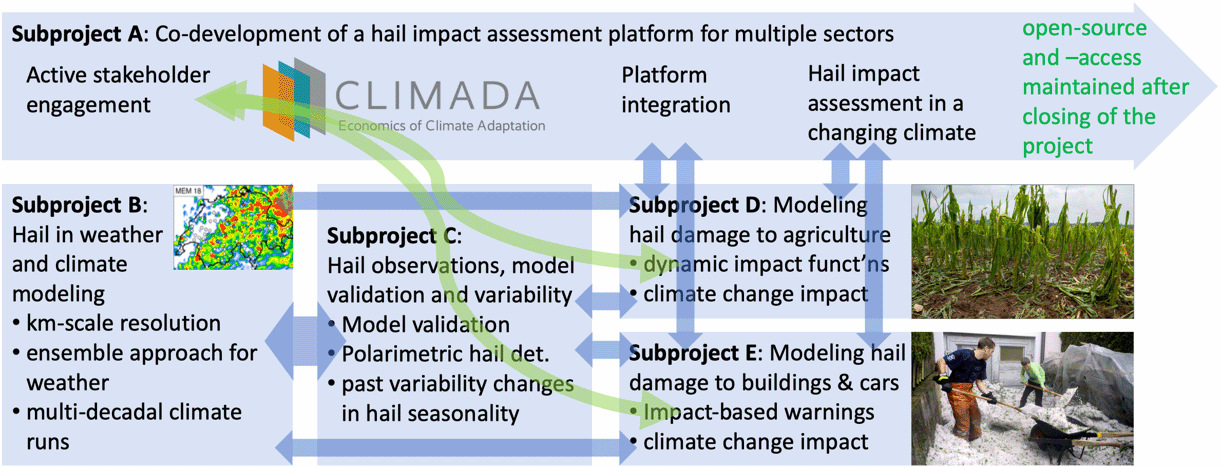Subprojects

PI: David N. Bresch; Partners: Cornelia Schwierz (MeteoSwiss), Stefan Brem (Federal Office for Civil Protection)
Fully probabilistic quantification of hail risks and sector-specific impacts has not yet been undertaken at a granularity relevant for actual decision making by specific users in Switzerland. Substantial improvements in spatial and temporal resolution are expected from the concerted effort in forecasting and modeling of hailstorms in subprojects B and C. Through active stakeholder engagement right from the start of the project, we will further co-develop the existing open source and -access impact modeling platform CLIMADA to integrate outcomes of B and C in order to cover hail risk in Switzerland for multiple sectors, with a focus on applications in agriculture (subproject D) and insurance (subproject E) and to provide impact-based warnings in a semi- operational fashion. To complement this effort on the pre-operational scale, insights in the future evolution of hailstorms in a changing climate will allow to inform sectoral adaptation strategies to strengthen societal resilience against hail risk also on longer timescales.
PI: Heini Wernli; Partners: Christoph Schär (ETH Zurich), Marco Arpagaus (MeteoSwiss), Nikolina Ban (U Innsbruck), Becky Adams-Selin (Atmospheric and Environmental Research (AER), U.S.)
In a preceding SNF-funded Sinergia project (external page crClim), we have developed the capability to conduct decade-long simulations over continental domains with a grid spacing of 2 km, which enables the explicit representation of thunderstorms (Schär et al. 2020). This subproject builds on this achievement in order to (i) investigate the capacity to simulate and predict hail with current operational ensemble numerical weather prediction (NWP) and climate models, using the hail diagnostic HAILCAST, and (ii) assess the occurrence of hail in present-day and near-future (mid-century) climate simulations. A hail cell tracking with high temporal resolution will be developed for analyzing the characteristics of hail cells and their environment in complex orography, both in NWP and climate simulations. Case study simulations will be made with COSMO, the currently operational NWP model in Switzerland, and with the next-generation weather prediction and climate model ICON.
PI: Olivia Martius; Partners: Urs Germann (MeteoSwiss), Luzius Thomi (Die Mobiliar)
New radar-derived hail data, crowd-sourced hail size reports, damage data from insurance companies and as of summer 2020 a novel network of 80 automatic hail sensors provide hail information at unprecedented resolution for Switzerland. Important damage relevant hail characteristics can be assessed with this unique data trove such as the evolution of hail size and precipitation during the life cycle of hailstorms. The data also point to high year-to-year variability of Swiss hail occurrence that begs for an identification of key local and remote drivers to better understand and frame projections of future hail variability. The objectives of Subproject C are (i) to provide observational hail data to all subprojects, (ii) to verify the hail simulations of Subproject B, (iii) to quantify the Lagrangian evolution of hailstorms in terms of co-occurrence of hail and precipitation and associations with polarimetric radar information (e.g., ZDR columns), and (iv) to identify key drivers of past inter- annual hail variability and changes in hail seasonality north and south of the Swiss Alps. To reach these objectives we rely on a close collaboration with MeteoSwiss.
PI: Pierluigi Calanca; Partners: Annelie Holzkämper (Agroscope)
Crop-hail damage functions have been developed in the past for various crops, taking into account differences in their sensitivity depending on development. However, no attempt has been undertaken as of today to integrate such functions into process-based models of crop growth. The possibility to simulate crop phenology and sensitivity to hail damage in a dynamic way is essential to be able to (a) map current risks and develop probabilistic, short-term risk forecasts, (b) capture future shifts in the seasonality of crop sensitive stages induced by increasing temperatures and therefore develop likely scenarios for hail damages under climate change. The goals of subproject D are to (i) develop dynamic crop-hail damage functions for annual crops and grapevine, (ii) conduct hindcast studies to test reliability (iii) integrate crop-hail damage functions and exposure models into the CLIMADA platform, and (iv) use the latter for assessing potential hail damages under climate change.
PI: David N. Bresch; Partners: Marc Wüest (Swiss Re), Mirco Heidemann (GVZ)
We will expand the existing open-source and -access impact modeling platform CLIMADA to cover hail risk to buildings and cars, as no similar effort has been undertaken for more than a decade (HailCalc 2007). Partners in both direct insurance (GVZ, also granting access to other cantonal insurers) as well as reinsurance (Swiss Re) will provide us with access to detailed damage data both for buildings and cars. In combination with high-resolution characterization of hail events from subprojects B and C, we will calibrate and validate the impact model in close consultations with key stakeholders to render it ready for (i) semi-operational use, not least by MeteoSwiss and (ii) to use the model chain for assessing potential hail damages under climate change.